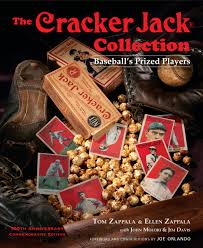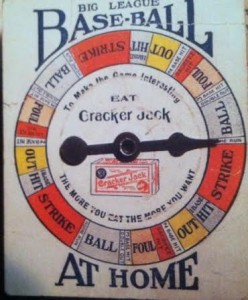 The Cracker Jack® Collection …
The Cracker Jack® Collection …
Baseball’s Prized Players
By Tom Zappala and Ellen Zappala
2013, Peter E. Randall Publisher
$30.00
Take me out to the ball game.
Take me out with the crowd.
Buy me some peanuts and Cracker Jack
I don’t care if I never get back.
If you are a baseball fan, those words – and the melody that accompanies them – are no doubt close to your heart. Cracker Jack® and our national pastime have a close and long-standing relationship. The recently released coffee table book The Cracker Jack Collection … Baseball’s Prized Players illustrates just how deep and enduring that relationship was and continues to be. If you’ve ever enjoyed joining in a seventh-inning rendition of Take Me Out To The Ballgame, Baseball Roundtable is confident you’ll enjoy The Cracker Jack Collection. The book commemorates the 100th Anniversary of the first Cracker Jack baseball card set – in 1914 and 1915, the treasured prize in each box of Cracker Jack was a baseball card. It tells the tale of Cracker Jack’s rise to confectionery prominence and its century of ties to baseball, as well as the presenting the statistics and stories of the players honored on the Cracker Jack cards (144 cards in 1914, 176 in 1915). Those players are Baseball Hall of Famers, Hall of Fame “should-have-beens” and journeymen who took the field in the game’s rough-and-tumble early years.
 The Cracker Jack baseball cards are among the most valued and valuable in the card-collecting community, and The Cracker Jack Collection is a must-have for the collectors of vintage sports cards. The book, however, has a much broader appeal. Baseball fans, nostalgia buffs, and those interested the life and times of the early 20th century will all find something to like in this book. Co-authors Tom and Ellen Zappala clearly brought a passion for the history and heritage of the national pastime to their work, and they supplemented their efforts with contributions from Joe Orlando (president of Professional Sports Authenticator and PSA/DNA), John Molori (Boston Baseball Magazine columnist) and Jim Davis (charter member of the Cracker Jack Collectors Association).
The Cracker Jack baseball cards are among the most valued and valuable in the card-collecting community, and The Cracker Jack Collection is a must-have for the collectors of vintage sports cards. The book, however, has a much broader appeal. Baseball fans, nostalgia buffs, and those interested the life and times of the early 20th century will all find something to like in this book. Co-authors Tom and Ellen Zappala clearly brought a passion for the history and heritage of the national pastime to their work, and they supplemented their efforts with contributions from Joe Orlando (president of Professional Sports Authenticator and PSA/DNA), John Molori (Boston Baseball Magazine columnist) and Jim Davis (charter member of the Cracker Jack Collectors Association).
First and foremost, the focus of The Cracker Jack Collection is the players selected for the Cracker Jack card sets. The Zappalas bring these players – and the era they played and lived in – to life, not only by documenting their on-field achievements, but with entertaining and informative glimpses into their off-field lives. They not only inform the reader that Ty Cobb batted under .320 only once in his career, but shine a light on his business acumen, which led to his investments in companies like Coca Cola and General Motors. Walter Johnson’s profile includes his remarkable 110 complete-game shutouts, and his unsuccessful run for Congress. Eddie Plank’s 26-6, 2.22 record in 1912 is featured, as his post-baseball service giving guided tours of the battlefield at Gettysburg. BBRT note: The Plank profile also includes his winning assignment as the starting pitcher in the April 12, 1909 first-ever game at Philadelphia’s new Shibe Park; which saw Plank win 8-1, but also saw his catcher Doc Powers collide with the stadium’s cement wall and suffer ultimately fatal internal injuries.)
The Cracker Jack Collection brings these players – and the era they played and lived in – to life, not only by documenting their on-field achievements, but with entertaining and informative glimpses into their off-field lives.
Throughout The Cracker Jack Collection, readers will find the career statistics and life stories of well-known “prized” players like Cobb, Johnson, Plank, Honus Wagner, Tris Speaker, Christy Mathewson, Nap Lajoie, Rube Marquard and Mordecia Brown, as well as front office greats like Charlie Comiskey, Clark Griffith, Connie Mack and Branch Rickey.
While I enjoyed the profiles of the collection’s best-known stars, I found myself drawn to some of the lesser-known players honored in the Crack Jack Collection.
For example, long before baseball statistical guru Bill James, there was “Seattle Bill” James, who ran up a 26-7, 1.90 record for the 1914 “Miracle Braves” of Boston (and won two games without giving up a run in the World Series that year). A star in the making, James developed shoulder problems in the off season – and finished his MLB career with just 37 wins.
Also honored is first baseman Jake Daubert. Daubert led the NL in batting in 1913 and 1914 and, as the Zappalas tell us, was a sparkling fielder, hit over .300 in 10 of his fifteen major league seasons, was Baseball Magazine’s All Star first baseman in 1911 and every year from 1913 to 1919, and captured the Chalmers Award (MVP) in 1913. The authors chose Daubert for their Cracker Jack Collection All Star Team and rightly note that “It is hard to fathom why Jack Daubert has been bypassed by the Hall of Fame.”
There was John “Dots” Miller, considered by many one of the best utility players of the dead ball era. In The Cracker Jack Collection, you’ll not only find his MLB statistics, but the story behind his nickname. Early in his career, Miller was all-time great shortstop Honus Wagner’s double play partner and (due partly to their shared German heritage) close friend. One day a reporter came up to Wagner and asked who the new kid at second base was. With his German accent, Wagner replied “Dot’s Miller” – and a nickname was born.
As I read through The Cracker Jack Collection, I also was entertained and caught up in the biographical sketches of players like Rebel Oakes (a speedy, slap-hitting outfielder); Dick Hoblitzell (a steady-hitting first baseman and Babe Ruth’s Boston roommate from 1914-18); Armando Marsans (one of the first successful players out of Cuba, who ran a Cuban cigar factory in the off season); and Al Wentworth Demaree (who enjoyed an eight-year career as an MLB pitcher and went on to become one of the best known sports cartoonists ever – syndicated in 200+ newspapers and published in the Sporting News for three decades).
I could go on, but the point here is that the stories you’ll find in The Cracker Jack Collection’s player profiles are a good match to the Cracker Jack slogan “The more you eat – the more you’ll want.” In this case, the more you read, the more you’ll want – and the more you’ll find yourself wanting to share these tales with baseball-loving friends. As Boston Herald Editor-in-Chief Joe Sciacca said of The Cracker Jack Collection, “If you’re looking for fresh yarns to tell during the next rain delayed game, you’ve come to the right place.”
While the players dominate the book, it also chronicles the history of the now iconic Cracker Jack – all the way back to 1871 and German immigrant Frederick William Rueckheim. As the story goes, the breakthrough came with the development of a way to prevent the caramel-coated popcorn and peanut confection from sticking together. The Cracker Jack Collection takes us through the development of product, its name and logo, its marketing and the history of Cracker Jack’s prize offerings – the largest of which was a Winnebago Recreational Vehicle (in 1981, one fortunate snacker found a message in his box of Cracker Jack telling him how to claim his Winnebago prize). BBRT note: Cracker Jack prizes – now legislatively limited in scope – have, over time, been made of paper, wood, cast metal, tin, terra cotta, Bakelite, chenille, rubber, felt, straw, cellophane, fiber, papier-mâché, cloth, string, wire, candy, aluminum, celluloid, ceramic, rattan, glass and plastic.
 The first Cracker Jack baseball-related prize was a 1907 post card featuring a pair of bears playing baseball. Over the years, Cracker Jack has offered (among others) such items as a Cracker Jack Movies pull-tab toy that changed from a batter to an umpire; A Big League Baseball At Home spin-dial game; baseball player buttons; plastic baseball stand-up figures (two whole teams of blue and gray); plastic miniature baseball caps, bats and gloves; and additional baseball cards.
The first Cracker Jack baseball-related prize was a 1907 post card featuring a pair of bears playing baseball. Over the years, Cracker Jack has offered (among others) such items as a Cracker Jack Movies pull-tab toy that changed from a batter to an umpire; A Big League Baseball At Home spin-dial game; baseball player buttons; plastic baseball stand-up figures (two whole teams of blue and gray); plastic miniature baseball caps, bats and gloves; and additional baseball cards.
Whether it’s the player profiles, the history of Cracker Jack or the story of the 1914 and 1915 card sets themselves, the book is well-researched and well-written. Further, it is also beautifully designed and illustrated. The quality of the images of the cards, past Cracker Jack packaging, prizes and advertising, and vintage baseball equipment, all live up to the quality of the prose. The Cracker Jack Collection now rests proudly on BBRT’s coffee table – and Tom and Ellen Zappala’s 2010 book, The T206 Collection: The Players and Their Stories, is at the top of my Christmas list.
The Cracker Jack Collection can be ordered online at http://www.crackerjackplayers.com/order.html






